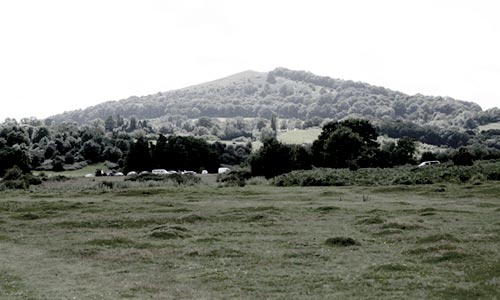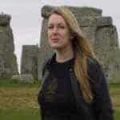POLLYANNA JONES tells the dreadful tale of a curse from long ago that still haunts the Malvern Hills in Worcestershire

‘May all upon whom the shadow of this stone falls untimely die!’
This dire curse is said to have been cast from the peak of Raggedstone Hill, one of the peaks along the ridge of the beautiful Malvern Hills in Worcestershire. Better known for its sparkling springs, sweeping views of the Shires, and Edward Elgar, this beautiful region seems an unlikely place to find a dreadful tale of suicide and revenge.
Legend tells how a man named John was forced against his will to join the Order of Benedictine Monks at the Little Malvern Priory of St Giles. As can be expected, he struggled to settle into the disciplined and pious life of the righteous, and loved nothing more than the hours spent out of the Priory’s walls when sent to gather medicinal herbs from the Common.
One morning, he was out collecting burdock and dandelion roots, when he heard the sweet voice of a woman singing. Following the enchanting sound, he came across a fair young woman washing her clothes and herself in a nearby pool. Brother John was smitten, and from that day on would ensure that his herb-gathering brought him to this spot in case he should find her again. Secretly he would watch her bathe and sing her sweet melodies, but soon the girl discovered him, and rather than be shy about it, only encouraged her admirer. Forbidden for a monk to break his vow of chastity, she was sure it was just a bit of fun end enjoyed playing the tease.
This innocence was not to last, however. Brother John was a handsome chap, and soon managed to steal a kiss. It was not long before the two found themselves falling in love. Then the inevitable happened one summer’s morning. After the deed was done, the monk panicked, realising that he was late to Matins. He ran back to the Priory as fast as he could, but found that the Prior and the rest of the monks were waiting for him. His secret it seems was not a secret at all. Some of his brothers of the cloth had been spying on him and had informed the Prior about his romantic adventures.
The Prior was a much-feared man, and demanded to know the name of the wicked temptress who had led the monk into sin. Brother John refused to betray the woman he loved. The Prior set a punishment for the lustful monk; that he would be made each day to crawl up Raggedstone Hill on all fours form its foot to summit where he would pray to God for forgiveness. Then on all fours he would crawl back down, until he repented and gave the name of his lover to the Prior.
Each day Brother John would crawl over the sharp rocks, through stinging nettles and scratching brambles and gorse. But when questioned after completing his dreadful task, he refused to give the girl’s name. His bruises had no time to heal and soon his scratches and cuts became infected sores, despite the best efforts of the Priory’s herbalist.
Delirious with fever, Brother John made that agonising journey again to the summit, barely reaching the top. As he pulled himself towards the peak, gasping for breath, he saw a sight most strange. From between the twin peaks of Raggestone Hill, a long cloud appeared, and threw its darkness down the hill casting a shadow over the monks below. Brother John was filled with a new-found strength, and using the last of his power stood tall in defiance of his torturers. Pointing at them, he bellowed a terrible curse, ‘No prayers for me today. Instead, I put a curse on my punishers. May any whom this shadow falls upon die before their time, as I do.’
Closing his eyes, happy that his lover’s identity was safe, Brother John leaned over and threw himself off the hill into a valley far below. Within a month, the Prior had died of wasting disease. The Priory itself soon after seemed to die, and by 1480 Bishop Alcock found it to be in a state of ruin. The remaining monks and their Prior were sent to Gloucester Abbey for two years ‘by reason of their demerits’ in allowing the Priory to fall into such a state.
There is speculation around this tale and it is quite possible that the story was based on an 1888 novel by Charles F. Grindrod entitled “The Shadow of the Raggedstone”. The plot tells how a monk from Little Malvern Priory defies a vow of chastity and falls in love with a local woman. His penance is to crawl up the hill on his hands and knees, until dying from his ordeal, he casts his curse with his last breath.
The tale soon stuck with the Malverns, and even inspired a poem by Wilfred Gibson, writing during the First World War about a soldier and his sweetheart:
“As I was walking with my dear, my dear come back at last,
The shadow of the Ragged Stone fell on us as we passed;
And if the tale be true they tell about the Ragged Stone,
I’ll not be walking with my dear next year, nor yet alone.”
However, folklore inspires fiction, as well as fiction becoming legend. The lines between the two often blur, and the whole story is said to be an elaboration of a real event whereby a dispute over land took place between the monks of Little Malvern and Sir John Nanfan of Birtsmorton.
According to Roy Palmer, in “The Folklore of Hereford and Worcester”, Nanfan enclosed land, some of which the monks claimed as theirs. One day, Sir John found a monk on Raggedstone Hill, part of the area in contention, and ordered him off. The monk retorted that this was the monastery’s land, and if Nanfan failed to restore it, God’s judgement would be called down upon him. ‘Do your worst’, replied Sir John. The monk pronounced the formula of excommunication, and when Nanfan remained defiant, prophesied that whenever the shadow of the hill fell on Birtsmorton Court, the oldest son of the house would die within twelve months. As he spoke, the shadow fell on the house. Nanfan’s oldest son died within the year.
Over the centuries, unexpected deaths among Nanfan heirs were attributed to the curse. These include a fall from a horse, a casualty during the English Civil War (the only royalist to die in a skirmish in the Leadon Valley), and a duelling victim after the Restoration. In 1704, the entire elder branch of the Nanfan family was extinguished, and the malediction transferred to a junior branch which itself died in poverty at Worcester in the nineteenth century.
Other deaths attributed to the sighting of this shadow include the Duke of Clarence who was arrested soon after the vision and drowned in a cask of wine, Richard III who was the last English king to be killed in battle, and his nephew, Edward V who was one of the tragic princes in the Tower, and Cardinal Wolsey shortly before he fell from power and died of sickness.
When we look at the possibility of such a shadow appearing, there are factors to consider. In the legend around Birtsmorton Court, the respective positions of the house and the hill mean that the shadow can only fall on a particular day in November providing it is a sunny day; something that is rare for the time of year. There is also a meteorological phenomenon around the Malverns, where shrouding mists appear at times and roll down from the hills, casting parts of the Common below in a dark shadow. This could certainly have appeared from Raggedstone Hill in the legend of Brother John.
Take heed, that the shadow is very much a real thing, and history has recorded doom befalling those that have fallen beneath it. Should you decide to go walking in the southern Malverns, best avoid November. And if you see a shadow or mist, run!


